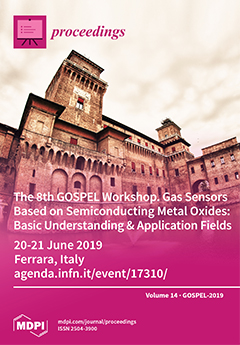Need Help?
Proceedings, 2019, GOSPEL 2019
The 8th GOSPEL Workshop. Gas Sensors Based on Semiconducting Metal Oxides: Basic Understanding & Application Fields
Ferrara, Italy | 20–21 June 2019
Volume Editors:
Vincenzo Guidi, University of Ferrara, Italy
Cesare Malagù, University of Ferrara, Italy
Barbara Fabbri, University of Ferrara, Italy
Matteo Valt, University of Ferrara, Italy
- Issues are regarded as officially published after their release is announced to the table of contents alert mailing list.
- You may sign up for e-mail alerts to receive table of contents of newly released issues.
- PDF is the official format for papers published in both, html and pdf forms. To view the papers in pdf format, click on the "PDF Full-text" link, and use the free Adobe Reader to open them.
Cover Story (view full-size image):
GOSPEL is an international biannual research meeting dedicated to R&D activities in the field of semiconducting metal–oxide-based gas sensors. The 8th edition of this Workshop series will
[...] Read more.
GOSPEL is an international biannual research meeting dedicated to R&D activities in the field of semiconducting metal–oxide-based gas sensors. The 8th edition of this Workshop series will be hosted for the first time in Italy, which boasts a good number of consolidated research groups on these topics. The aim is to bring together academia and industry and help the latter to identify which of the new developments are the most relevant to it.
Previous Issue
Next Issue
Issue View Metrics
Multiple requests from the same IP address are counted as one view.



